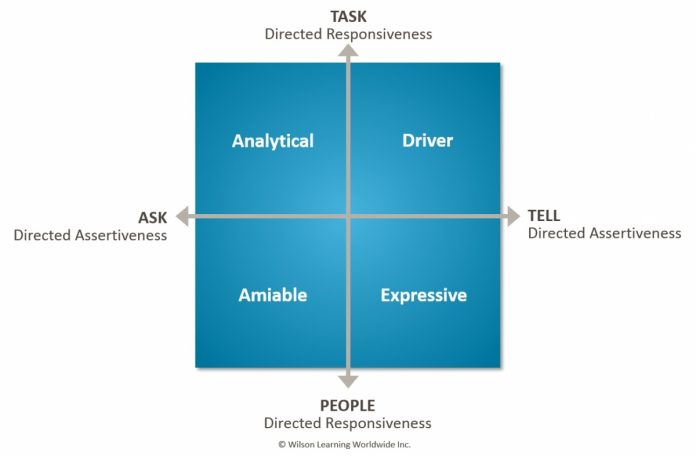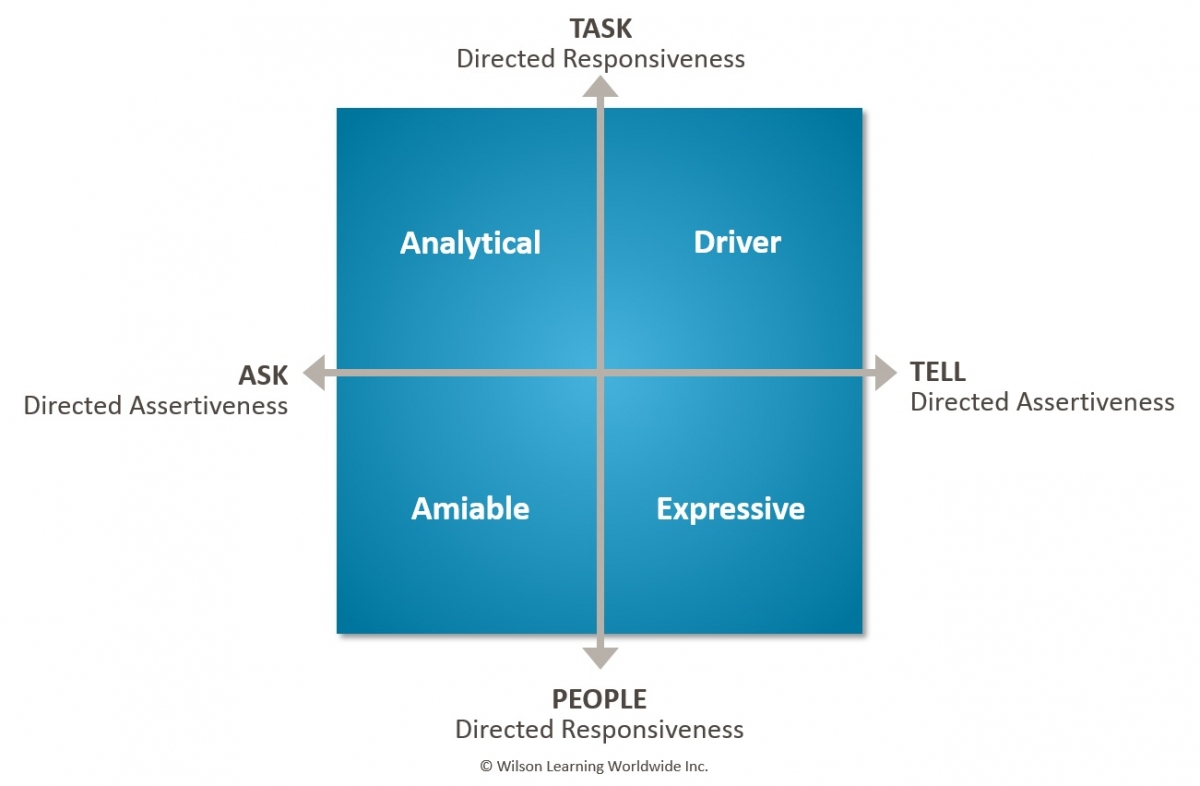
What if your company could learn a skill that would eliminate conflict, miscommunication, and slow decisions? And what if we told you that the mechanics team inside a global air fleet company did just that and saw a 56 percent boost in productivity? Would we get your attention? Thought so.
That skill is called Versatility, and it is perhaps the most powerful interpersonal skill you can have.
Today’s mandate to “perform well,” on whatever task it may be, is dependent on functionally and culturally diverse people within and outside the organization making high performance happen and happen fast. It is difficult to get good innovative decisions and actions carried out with high energy when people feel there is tension and communication is strained. The good news is we can take responsibility for managing our communication behavior and reducing interpersonal tension, keeping the task focused on solving problems and achieving improvements of productivity, efficiencies, and employee engagement.
Versatile Communication Skills
Versatility is the ability to recognize differences in communication preferences and to adapt to make others more open and receptive—creating more effective and productive relationships.
The first step is to recognize communication differences, and the Wilson Learning Social Styles model can help there. Social Style is based on our preferred communication approaches. Your Social Style varies in terms of your actions on the dimensions of Assertiveness and Responsiveness.
The Social Styles Model

Because approximately 25 percent of people fall into each of these four categories, you share a Social Style with only about 25 percent of the people you meet. Just think about the consequences when we can’t or won’t adapt to the other 75 percent. Do you see an opportunity here?
“The more I know about you, the more I know about me,
and the more I can take responsibility for managing the difference between us.”
If you choose to take responsibility and manage the differences between your Social Style preference and the other 75 percent, you can create more productive relationships and, as a result, maximize your effectiveness on the job.
The Key Is Versatility
Social Style helps you recognize communication preferences, and Versatility helps you take responsibility for managing differences. The good news is Versatility is a skill that can be learned and mastered. But Versatility requires effort, requiring you to modify your approach to fit others’ approaches, even when it may not be comfortable. You have to make a conscious choice to be Versatile:
- Do I need this relationship to work so I can achieve my results?
- What will the benefits be if I improve this relationship?
- What will the risks be if I do not improve this relationship?
Having chosen to be Versatile, you then have to act on that choice with a process we call the Versatile Response:
The Versatile Response
Identify
Identify the person’s Social Style.
“She or he is . . .”
Reflect
Based on the person’s Social Style, reflect on and describe her or his expectations for interactions with you.
“So she or he needs . . .”
Modify
Decide how to modify your behaviors to maximize your effectiveness.
“Therefore I will . . .”
1. Identify: What is the person’s Social Style?
You identify others’ Social Styles by focusing on what they value, the environment in which they work best, and how they like to work.
Analyticals, for example:
- Value conservative and practical business decisions
- Rely on structured approach and factual evidence
- Prefer a systematic approach to coming to a recommendation
Amiables tend to:
- Value cooperation in business situations
- Rely on the support of others in shared decision-making
- Prefer an interactive approach to problem solving
Drivers tend to:
- Be forceful and quick in making decisions
- Flourish in a goal-oriented environment
- Expect others to respond in a timely manner
Expressives tend to:
- Be futuristic in their thinking
- Attempt to make others enthusiastic about ideas
- Prefer a collaborative approach to problem solving
2. Reflect: What does this person need from me interpersonally?
How you modify your Social Style depends on both the other’s Social Style and the situation. There is no one straightforward solution. An Analytical (or Driver, Amiable, or Expressive) in one situation may need something different in another situation.
An Analytical, for example, may need a more formal and structured approach, or may just need enough time to think things through. An Amiable may need you to be open and honest about your feelings, or need other people to be involved in the decision. A Driver may need you to get right to the point, or focus a little more on the problem and less on the people involved. And an Expressive may need you to be a little more flexible on time, or to hear your excitement for the issue.
So before going straight from Identify to Modify, pause a second to reflect: What does this Social Style need? And what is needed now?
3. Modify: What can I do to modify my behavior?
People new to Versatility skills sometimes think you have to make big behavior changes to communicate effectively. But just like the old adage, “the best things come in small packages,” little changes in Assertiveness and Responsiveness can have a big impact on the effectiveness of communication. Maybe all you need to do is:
- Ask for the other person’s opinion first
- Get to the point quickly
- Use a slower or faster pace
- Use more or less gestures and facial expressions
How might this work in the real world? Here are some examples:
A VP of Research and Development (an Analytical) was frustrated because he was not receiving responses from e-mails to the VP of Sales (a Driver). Upon reflection, he realized the VP of Sales needed to get right to the point, and the lengthy explanation of the data and how he reached his conclusion was not helping the VP of Sales. So with the next e-mail, the VP of R&D “flipped” the message; he put the conclusion first, the explanation second. The VP of Sales responded immediately.
The VP of Marketing (a Driver) was having trouble getting the Website Design Manager (an Amiable) to make changes to the corporate Website. The VP of Marketing paused for a moment and realized that the Website design manager always felt more comfortable when more people were involved in decisions. So the VP of Marketing asked her who else might be able to contribute to this decision and invited them all to a meeting to discuss the changes. After the group made the decisions, the Website design manager implemented them almost immediately.
When Soft Skills Yield Hard Results
Equipping your employees and leaders, in all functions, with Versatility skills enables them to address complex challenges, reduce tension and conflict, and build more collaborative relationships throughout the organization. Without communication obstacles, individuals, teams, and work groups can soar as they are free to focus on the work at hand. Join the ranks of the global air fleet maintenance team and boost your productivity to new altitudes.
If you would like to learn more about Wilson Learning’s results-driven programs, including Building Relationship Versatility, visit www.wilsonlearning.com or call 800.328.7937.
Tom Roth is chief operating officer for Wilson Learning Worldwide. He is responsible for the strategic direction and business performance of Wilson Learning Worldwide operations, and leads the global marketing services and R&D solutions group. He also served as president of Wilson Learning Americas. He assists global executive leadership teams with issues related to employee engagement, leadership development, strategy alignment, and business transformation. Roth has spent more than 35 years developing and implementing human performance improvement solutions. He is coauthor of the book, “Creating the High-Performance Team.”
Michael Leimbach, Ph.D., is vice president of Global Research and Development for Wilson Learning Worldwide. With more than 30 years in the field, Dr. Leimbach provides leadership for researching and designing Wilson Learning’s diagnostic, learning, and performance improvement capabilities. He has managed major research studies in sales, leadership, and organizational effectiveness, and has developed Wilson Learning’s Instructional Design methodology, Impact Evaluation capability, and return on investment models. Dr. Leimbach has served as a research consultant for a variety of global client organizations, is associate editor for the ADHR professional journal, and serves in a leadership role for ISO technical committee TC232: Standards for Learning Service Providers. He has coauthored five books.



